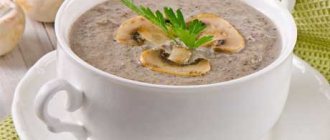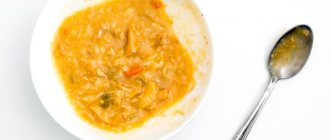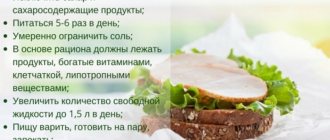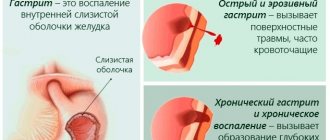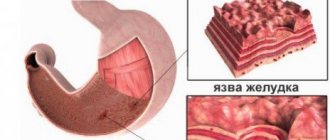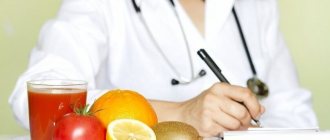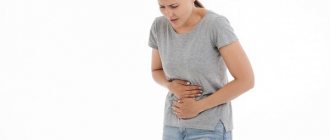Vomiting is the involuntary emptying of the stomach through the mouth, an unpleasant phenomenon that affects absolutely all age groups. It happens especially often in children due to the formation of the gastrointestinal tract.
Most often, the cause of such an incident is the use of low-quality products. But sometimes vomiting indicates a serious illness (from the gastrointestinal tract - dysentery, salmonellosis, gastritis; traumatic brain injury as a reaction to an increase in temperature). It is important to know what you can feed your child after vomiting. However, before thinking about nutrition, parents need to show the child to a specialist to rule out the presence of pathology.
Diet for poisoning in a child, which foods should be excluded from the diet
During an exacerbation, you should completely stop eating. You need to increase your drinking in small portions, the more often the better.
It is necessary to exclude all foods that can irritate the intestines and stomach.
This includes:
- pasta;
- sausages;
- spicy, smoked, fried, and fatty foods;
- marinades and pickles;
- canned food;
- freshly baked white bread or sweet pastries;
- strong tea and carbonated drinks;
- millet, corn and pearl barley porridge;
- whole milk;
- butter;
- sour cream sauces, mayonnaise;
- chocolate, pastries, cakes;
- sour berries;
- fast foods;
- soups with broths and many ingredients;
- fatty fish and meat;
- peas and beans;
- fruits: tangerines, oranges, apples;
- nuts;
- vegetables: onions, mushrooms, cabbage of any kind and cucumbers.
If the case concerns a child, you should immediately call an ambulance or take the child to the hospital yourself. An on-site specialist will provide the necessary assistance and information.
https://youtu.be/9aO9jJ-60OY
Dishes and foods to avoid
Contrary to popular belief, not all cereals are easily digestible. During the recovery period, it is better to give up cereals such as pearl barley, wheat, barley, and semolina. Juices contain a large amount of fruit sugars and acids, they irritate the delicate mucous membrane of the children's stomach. Fresh bread and baked goods are difficult to digest, as are sweets, which are classified as high-carbohydrate foods. Potatoes and pasta are recommended to be consumed only for 3-4 days.
Do not give children fresh fruits, vegetables, or herbs after vomiting. Butter, sunflower oil and other fats will not bring any benefit, but will only increase the load on the liver and pancreas. Fatty meat and fish are not recommended for the same reason. You should avoid sauces, carbonated drinks, sausages, and smoked meats.
If vomiting is accompanied by diarrhea, you should be careful when consuming beets, plum and prune compote, and kefir. Preference should be given to rice, hard-boiled eggs and cottage cheese.
What can you eat if you are poisoned and vomiting?
The first thing that needs to be observed in case of vomiting and poisoning is the drinking regime. This is especially necessary if there is a high temperature. Due to fluid loss, intoxication and dehydration occur. An alkaline liquid is suitable as a drink; give it until the temperature subsides, the gag reflex and loose stools stop.
Only when the exacerbation is relieved can you switch to a gentle diet. Use food that is easily digestible and does not injure the body. Dishes should only be served in a liquid and pureed state. Cook food by steaming, oven or boiling.
List of recommended products:
- Grated vegetables (potatoes, carrots).
- Puree soups.
- Chicken broth, you need to collect all the fat.
- Mashed potatoes.
- Rice meatballs, meat soufflé. Meat you can eat is beef, chicken, turkey.
- A drink made from dried fruits, raisins or rose hips. Jelly made from non-acidic berries helps effectively.
- One percent kefir.
- Porridge with water: rice, buckwheat, oatmeal.
- Homemade low-fat yogurt without added sugar.
You need to understand that at first the portions should be minimal. Meals should be fractional, up to six times a day. Every day the portion can be increased, constantly monitoring the child’s condition.
If the baby is very small, then you can breastfeed and buy pureed purees in specialized stores or pharmacies.
Along with food, you must not forget to give water and sorbents, which will help remove toxins and quickly restore the child’s body.
Linden and chamomile are used as herbal infusions.
Diet for poisoning in a child, what it should be, what you can eat and what you can’t, watch the video:
Nutrition after vomiting for adults
Nausea and vomiting can occur for various reasons. The consequences of this condition depend on the negative factor that provoked the symptom. What the treatment will be is determined by the attending physician, but the primary task of the specialist is to adjust the diet and clearly inform the patient about what can be eaten after vomiting.
If an attack of vomiting occurs, you should determine what caused the discomfort and eliminate the cause. The following factors can cause nausea:
- oversaturation with food;
- disordered eating pattern;
- intoxication with spoiled foods;
- digestive system dysfunction;
- toxicosis of pregnant women;
- diseases of infectious nature;
- alcohol poisoning;
- chemical poisoning;
- the body's response to long-term drug treatment;
- food allergies;
- pathological changes in the nervous system.
Diarrhea and vomiting are the body’s way of cleansing itself of toxic compounds. In the first hours after the onset of symptoms, you should refrain from eating. Since in the process of incessant urge, a large amount of fluid is lost, it is important to prevent dehydration. In addition to establishing a drinking regime, you should find out from a specialist what to eat after poisoning and vomiting.
It is necessary to stop fluid loss, as loose stools and uncontrolled vomiting can lead to dehydration. The patient should be provided with adequate drinking regimen. Entering the stomach, water restores the function of the digestive system.
After the attacks have stopped, you can replenish your water balance with tea, pure water, or diluted juice.
You should drink frequently, in small sips, as large volumes can cause repeated cramps.
To restore the water-salt balance, it is recommended to drink mineral water or solutions saturated with microelements. The liquid should be started every 2 hours after vomiting stops.
If the pathological process worsens, you should not drink soda and milk. Since some people believe that signs of poisoning can be alleviated by drinking strong alcoholic drinks, it is worth dispelling this myth. Drinks containing alcohol worsen the condition of a sick person.
Rice decoction is good for soothing inflamed stomach walls. The liquid envelops the walls and eliminates the pain symptom.
Whatever the cause of the poisoning, generally accepted principles should be followed after vomiting. Pathological processes weaken the body and its protective functions. The food consumed should contribute to the rapid restoration of the digestive system.
When toxic compounds are eliminated:
- You should not eat foods that cause fermentation, as well as foods that take a long time to digest.
- On the first day after assistance, the ideal menu is considered to be crackers and still water, or drink tea without sugar with biscuits.
- A more varied diet may be on the second and third days. When the condition is stabilized, use low-fat chicken broth, mashed potatoes cooked in water, and low-fat fermented milk products.
- The lack of protein is compensated for by boiled fish and steamed meat.
Recovery processes should take place in a calm environment. Excessive physical stress is unacceptable. You should not eat foods that are difficult for the stomach.
What to pay attention to when creating a menu after vomiting:
- To prepare porridge, it is better to use buckwheat, rice or oatmeal.
- Boiled vegetables are ground into puree. In this way, coarse fibers are crushed.
- Rusks are prepared mainly from wheat bread. It is also acceptable to eat biscuits.
- Oranges and apples contain too aggressive fruit acids. Banana does not cause digestive upset.
- After vomiting, the apple must be baked before eating, and the carrots must be boiled.
- When choosing yogurt, preference should be given to a natural product without additives.
- Boiled eggs have a binding effect - this must be taken into account in case of indigestion.
- Before drinking, apple juice should be diluted in a ratio (1:1).
In the first days, to eliminate discomfort and restore the gastric mucosa, it is recommended to drink a decoction of rice - it is included in the list of anti-nausea products. Also, foci of inflammation are eliminated with jelly.
If there is no vomiting, but the nausea cannot be relieved, you can overcome the discomfort with the following products:
Ice cubes - you can eat when you feel sick, as they perfectly cope with unpleasant sensations and saturate the body with water.
The list of prohibited products mainly includes those that can provoke an inflammatory process and slow down the regeneration of hyperemic tissues.
The list of prohibited use includes:
- pickling, pickling;
- sour foods;
- prepared foods by frying;
- homemade and industrial jams;
- spices and hot spices;
- fresh vegetables and fruits;
- smoking;
- buns, sweet pastries;
- chocolate, desserts;
- sauces, mayonnaise, ketchup.
Animal fats and oils, entering a weakened digestive system, settle on the walls, provoking the appearance of pathological foci.
In the first days after vomiting, when the patient’s condition has stabilized, you should not abruptly return to your usual diet. Special care must be taken when handling spices.
During the recovery period, it is important to drink plenty of water. Also, in addition to the prescribed two liters in its pure form, it is necessary to add decoctions and compotes.
Eating excessively hot food and cold dishes is unacceptable, as they can cause tissue irritation.
How long to maintain a therapeutic diet for vomiting is determined by the doctor. Severe, prolonged vomiting, provoked by poisoning of various natures, requires long-term recovery. In some cases, the leading specialist recommends monitoring the gentle menu for up to 3 weeks.
If the vomiting was not prolonged and was limited to several attacks, the diet is maintained for a day or two. A painful condition caused by an intestinal infection or food poisoning requires a weekly dietary regimen. In some cases, gentle food is taken for several weeks - a month.
Vomiting often occurs unexpectedly and the cause is not related to poisoning. Signs of nausea can occur with hyperthermia, due to a viral infection, or overeating with unusual foods. Such vomiting does not require specific therapy. Doctors advise reducing the amount of food you eat and drinking more water. During this period, it is worth listening to the body. After vomiting and diarrhea, you should not eat in the first hours.
One day of a strict diet, after bouts of nausea and vomiting, looks like this:
| DIET | MENU |
| First meal | Soft-boiled eggs – 2 pcs.; Milk porridge from rice or semolina – 300 g; Tea with milk – 1 glass |
| Lunch | Steamed cutlets with olive oil; Mashed potatoes; Porridge is a mess, milky; Milk – 1 glass; bread |
| Dinner | Soup with added cereal – 1 plate; Steamed meatballs - 110 g; Potato puree - 150 g; Fruit jelly – 100 g |
| Dinner | Boiled fish - 100 g; Mashed potatoes with vegetable oil; Boiled rice porridge - 300 g |
| Before going to bed | Milk - 1 glass |
| During the day | Stale bread - 400 g; Granulated sugar - 50 g; Butter - 20 g |
If you vomited once or twice and stopped, you can eat a little lean meat broth. In the absence of symptoms for more than a day, food can be varied with buckwheat, rice, oatmeal, cheese, omelet, and milk porridge. How long after vomiting you can eat depends on the patient’s condition and the reasons that caused the malaise, but definitely, it is better to refuse food on the first day.
Poisoning often brings children of different age groups to the hospital. The cause of cramps and nausea is poor-quality food and failure to comply with personal hygiene rules. An increase in plasma ketone bodies is accompanied by acetonemic vomiting. The first symptoms cannot be ignored, since dehydration in children occurs quickly and leads to quite serious consequences. Due to fragile immunity, the disease is more severely tolerated in children than in adults.
After stopping the attacks, it is better to refuse food for the first time. Only after 24 hours can you offer your child to eat easy-to-digest foods after vomiting. If the baby is breastfed, the mother should carefully monitor her diet.
Next, you should adhere to the following recommendations in the question: “What can a child eat after vomiting?”:
- Children over the age of one year are given porridge with milk (1:1 with water), vegetable puree, cottage cheese, and juices;
- over a year - rice or buckwheat porridge with water, dried fruits.
To improve the function of the digestive system, you should purchase the following products:
- mashed bananas are a storehouse of microelements;
- baked apples - antioxidants;
- dried compote is a source of vitamins and minerals;
- boiled vegetables;
- natural yoghurts;
- kefir after vomiting should be low in fat.
Before serving, food should be cooled to the optimal temperature. If the patient's condition has stabilized, steamed fish and meat are introduced into the diet. Chicken broths after vomiting provide good support for damaged stomach tissues.
After the condition improves, portions should not be large, but food should be offered frequently.
Whatever the cause of the child's vomiting, you should provide the baby with enough water. If he refuses to drink, doctors supply fluid to the body through an IV. Water quickly removes toxins, and a water-salt solution helps eliminate the symptom.
The calculation of liquid per 1 kg of weight is approximately 150 ml. After vomiting, infants can drink water through a syringe without a needle, or from a teaspoon.
It is better not to offer tea after vomiting or give it without sugar, after brewing for a short time. It is more pleasant for children to drink dried fruit compote or a decoction of medicinal herbs.
With a gentle diet, signs of digestive system disorders subside after two days.
To speed up the recovery process, you should listen to the recommendations of professionals:
- You need to give your stomach a rest. At first, it is better not to feed the child after vomiting, and then the food should be light.
- Fluid lost due to vomiting must be quickly and regularly replenished to prevent dehydration.
- Food should restore the body's reserves without loading the digestive organs.
- It is strictly forbidden to consume aggressive foods (hot, fatty, fried, spicy).
- You can't eat hot or cold.
- Portions should be small and meals should be frequent.
If babies vomit, you should immediately call an ambulance.
Vomiting can cause serious complications and even death. The symptom requires emergency medical attention. Regardless of age, causes and therapeutic regimens prescribed by the leading specialist, the primary purpose is to adhere to the diet. In some cases, a diet after vomiting, fasting on the first day is the first step on the path to recovery.
source
The importance of proper nutrition after vomiting cannot be overestimated. A well-chosen diet can radically change the physiology of digestive processes, increase the rate of metabolic reactions, the body's regenerative abilities and, most importantly, enhance the effectiveness of a number of drugs.
Organizing a dietary plan for both adults and children requires a clear understanding of the causes of vomiting. The filling of the daily diet depends on this. The duration of the diet after vomiting is at least 5 days. This time is necessary for the body to have the opportunity to recover.
If the cause of vomiting is rotavirus infection, this period can last up to 4 weeks. It is fundamentally important to understand whether poisoning has occurred. Food intoxication requires gastric lavage (in severe cases) and a standard therapeutic regimen, which is completely unsuitable in other cases.
In order to understand the essence of what is happening, to provide adequate first aid, and not to harm a person, it is necessary to analyze the following points:
- taking into account the nature of vomiting - its frequency and frequency (a single or short episode can be a symptom of common nutritional errors, so-called indigestion);
- volume of vomit: profuse vomiting, guaranteed to lead to dehydration - a clear indication of serious disorders requiring immediate hospitalization;
- the composition of the vomit - for example, the presence of blood in it indicates the likelihood of injury, and this is a reason to immediately call an ambulance;
- taking into account concomitant symptoms (presence of fever, severe pain, character of stool) and previous diseases;
- and the main point is to clarify all the circumstances preceding vomiting (consumption of potentially dangerous foods, staying in a stuffy room, overheating, fatigue, bruises, injuries and falls, especially frequent in children, and common motion sickness in transport).
Note! Vomiting in children (much less often in adults) is often caused by emotional stress, mental stress, and the younger the child, the more likely it is to occur under the unfavorable combination of circumstances listed above. In such cases, after excessive vomiting, a vegetarian diet during the first 24 hours helps to relieve the digestive tract of the child and adult.
Restoring the body's water balance after vomiting is much more important than an adequate diet, especially at first. Uncontrollable vomiting, especially in combination with watery diarrhea, can dramatically worsen the body's condition within a few hours, causing severe dehydration. It can lead to tragic consequences when it seems that the person’s condition has stabilized.
Severe dehydration reduces the amount of important microelements, which are sources of ions, without which it is impossible for the most complex biochemical reactions that are vital for the body to occur. Fluid deficiency leads to a sharp increase in blood viscosity and a change in its characteristics, during which its main functions are lost, primarily in oxygen supply to tissues. Blood thickening causes red blood cells and other blood components to “stick together.”
Should I be forced if the child does not eat anything after poisoning?
When a baby refuses to eat, it is strictly forbidden to force him. If you feed “through I don’t want to,” this can cause a gag reflex and intensify the attack.
Don't worry if your child is hungry for several days. No one has ever died from this. On the contrary, a little fasting promotes a speedy recovery.
The main thing during this period is not to stop giving a lot of fluid.
But there is another danger: parents begin to indulge the child’s whims. Sometimes he refuses to eat or asks for some of the forbidden foods, counting on the pity of his parents.
If you indulge your desires, you can aggravate the problem and cause pain and the development of serious diseases of the gastrointestinal tract.
Effective properties of homemade jelly
Our ancestors knew about the medicinal properties of jelly. For many centuries they worked to improve the recipe to make the drink more effective. This is confirmed by the components that make up the drink.
It’s not for nothing that doctors recommend drinking jelly when you have diarrhea. Thanks to vitamins and amino acids, the easily digestible drink quickly brings the patient back to normal. Important body functions are launched:
- the presence of a high starch content in the drink helps to quickly stop diarrhea;
- choline normalizes natural fat metabolism;
- potassium maintains optimal acid content;
- Lecithin relieves increased amounts of cholesterol;
- methionine serves for the proper functioning of the pancreas and liver;
- the functioning of the gastrointestinal tract is improved;
- pantothenic acid improves hormonal balance;
- rapid elimination of toxins occurs;
- the intestinal system begins to function normally;
- kidney activity is restored;
- microbial imbalance is eliminated.
The density and thickness of the drink envelops and protects the stomach tissue.
The greatest benefit will come from a dish made at home.
Delicious recipes for dishes that children can eat after poisoning
You should completely avoid fried foods and cook everything stewed, baked or boiled. There are a lot of tasty and healthy dishes that children eat with pleasure.
Recipe No. 1: Meat soufflé
Components:
- 60 grams of any lean meat;
- half a small spoon of vegetable oil;
- five grams of bread;
- two large spoons of low-fat broth;
- one quarter of an egg.
Cooking principle:
- Wash the meat, remove the film and cut into small cubes.
- Send to simmer in a frying pan with added water.
- Pour cold water into a separate container to soak the bread.
- Cooked meat and bread should be minced several times.
- Add egg and chicken broth to the prepared mixture.
- Mix everything until smooth.
- Place on a baking sheet greased with vegetable oil, sprinkle some breadcrumbs on the bottom. The baking sheet must be covered with foil to create a greenhouse effect.
- Place the pan in the oven, and place a container of water underneath.
- The soufflé will be ready in twenty to twenty-five minutes.
Recipe No. 2: Steamed Meatballs
Ingredients:
- minced chicken – 220 grams;
- rice - fifty grams;
- salt to taste.
Cooking principle:
- Boil the rice, preferably half cooked.
- After it has cooled, mix it with minced chicken, add salt and form into neat balls.
- Place the meatballs in a steamer for forty minutes.
Recipe No. 3: Cocktail
You will need one banana and a glass of milk. Beat it all with a blender. This recipe can be used on the 4th day after an acute attack of poisoning.
The cocktail not only satisfies the feeling of hunger, but fills the body with useful microelements and vitamins.
There are many dietary recipes, so you can choose an option suitable for each child.
Recipes for children
If you need to prepare jelly for a baby who has suffered dehydration, then you can please the baby a little by sweetening the product. The following recipes are suitable for children:
- A child will really like pear jelly, especially if you sweeten it with sugar. For hot sugar, you need to use the following ingredients - 800-900 g of pears, 4 tsp of starch. Initially, the fruits need to be peeled and the core removed. The peel is soaked in a separate container with 2 liters of water). Place all this on the fire and bring to a boil. After this, the broth needs to be cooled and the pear, previously finely chopped and crushed in a blender, added to it. Add sugar to the resulting mass and pour in syrup. Dilute the starch in water, add to the jelly, let it boil and leave on the fire for half an hour. After this, cool and use as intended.
- Blueberry jelly is very pleasant to drink. It will help the child’s body cope with diarrhea faster and saturate the body with plenty of vitamins. It is very simple to prepare such a product. You will need 100 g blueberries, 1 spoon of starch, 1 liter of water, sugar. You should boil water, then add blueberries and sugar to it, leave on the fire for 20-25 minutes, then add starch and cook for another 15 minutes. It is important to constantly stir the product. After this, let it cool and use as intended.
Note! Kissel should not be given to persons who have been poisoned by milk jelly. In this case, it will only harm the body and increase diarrhea.
Gastric lavage in children
Sample menu for a recovering baby
You can follow the following menu:
Day #1:
- Breakfast: liquid oatmeal porridge, one boiled egg, green tea.
- Second breakfast: fruit puree, dried fruit compote as a drink.
- Lunch: liquid mashed potatoes, chicken mousse, jelly.
- Afternoon snack: baked low-fat fish.
- Dinner: rice porridge and banana.
Day #2:
- Breakfast: steamed omelette and oatmeal porridge.
- Second breakfast: banana puree, low-fat yogurt.
- Lunch: rice porridge cooked in water with meatball and jelly (meatball is made from turkey or chicken meat).
- Afternoon snack: compote and cottage cheese.
- Dinner: one banana, a glass of one percent yogurt.
Day #3:
- Breakfast: oatmeal with honey and black tea.
- Second breakfast: one banana and a dried fruit drink.
- Lunch: a piece of boiled meat (chicken, veal, turkey), stale bread or crackers, still alkaline water.
- Afternoon snack: crackers with chicken broth.
- Dinner: stewed or baked vegetables, fruit jelly.
Prepare vegetables, meat and compotes taking into account the child’s preferences. You can also ask your doctor to create a menu.
Let's watch the video and find out what foods you can eat if you are poisoned:
Baby's nutrition on the first day
In the first day after poisoning, the child should be offered enveloping foods, for example, porridge and jelly.
On the first day after the diagnosis of food poisoning, special attention should be paid to the child’s nutrition and eating habits. The first portion of food should be offered only when a feeling of hunger appears; it is not recommended to feed a baby who has no appetite at all.
In general, recommendations regarding the first day of poisoning are as follows:
- For the first meal, you should offer boiled rice or buckwheat porridge cooked in water. You can also use jelly without sugar or preservatives.
- Regardless of the child’s age, in the first two days it is advisable to grind cooked food using a blender. This will help to significantly reduce the load on the stomach and improve the condition of the microflora.
- Subsequently, it is permissible to feed the child food that has been previously cut into small pieces.
- On the first day, you can drink vegetable broths, after adding a few pieces of white bread to them.
- It is not recommended to add salt, spices or seasonings to cooked dishes.
- On the first day, you should offer your child food in small portions; it is not recommended to overload the stomach. It's better to eat several small portions throughout the day.
The cost of not following the above recommendations can be quite high. Poor nutrition, non-compliance with the diet, and consumption of foods from the list of prohibited foods can lead to the development of diseases of the digestive tract.
How to help a child recover?
In the first two weeks after vomiting, you need to carefully monitor your child's diet. To begin with, you should avoid products that contain dyes, preservatives and other chemicals - baked goods, sweets, juices, canned food, smoked foods, seasonings, etc. are not recommended.
It is worth limiting the amount of carbohydrates and fats. The child’s menu should include porridge, low-fat kefir, and yogurt. Be sure to include protein foods in your diet, in particular fish and chicken, but they need to be steamed. To restore the body, broths are suitable, to which you can add homemade noodles.
Gradually, familiar products can be introduced into the menu. But be careful - if vomiting was caused by poisoning with some foods, they should be carefully avoided.
Nutritional features of children under one year old
Children who are breastfed with complementary foods do not need additional nutrition during vomiting. Formula-fed babies digest rice and buckwheat mixtures with milk well.
Porridge made from buckwheat and rice is good for six-month-old children. They should be boiled in water and milk in a 1:1 ratio. Complementary feeding is allowed to be included in the baby’s menu after vomiting stops: this should be done gradually. The nutrition of a child aged 7-8 months requires the presence, in addition to porridge, of meat soufflé, vegetable puree, and fluffy cream soup.
What are the causes of vomiting?
Every parent at least once in their life was interested in the question of what to feed their child after vomiting. But first of all, it must be said that the regimen of treatment, nutrition and behavior during an attack of vomiting largely depends on the cause of this problem.
Vomiting may indicate a variety of disorders. Most often, this reflex manifests itself as a result of poisoning, consumption of poor-quality food or water, as well as against the background of infectious diseases of the digestive tract. Naturally, there are other reasons. For example, vomiting can occur with a head injury, concussion, or increased intracranial pressure. The same symptom accompanies such a dangerous disease as appendicitis. Vomiting can also be a manifestation of nervous shock or emotional stress, increased blood pressure, etc.
In any case, it is advisable to at least approximately determine what caused its appearance - perhaps your child urgently needs to be taken to the hospital.
What medications can I take?
Today, many parents are asking questions, for example, about what to feed their child after vomiting (5 years). These points have already been discussed above. And an equally important question is whether it is possible to stop such a process and help restore the body with the help of medications.
Naturally, you should never give your child any potent drugs without consulting a doctor. But if vomiting continues for a long time or repeats over several days, then naturally you need to worry about preventing dehydration.
A fairly good solution to the problem is Regidron powder, which must be dissolved in warm water before use. The saline solution will help restore the balance of electrolytes in the body. If you suspect that vomiting occurred due to poisoning, you can give your child activated charcoal or Smecta, which, by the way, is allowed for children almost from the day they are born.
